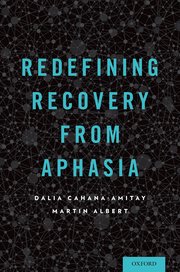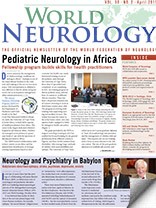BOOK REVIEW
By Murray Grossman, MD
Cahana-Amitay D and Albert M (2015)
Redefining Recovery from Aphasia
New York: Oxford University Press
281pages, with preface and index
Language is an incredibly complex process. Yet we speak and under- stand effortlessly in order to live our lives daily. The disruption of language following a stroke is a devastating blow to an individual’s day-to-day functioning because of our extreme dependence on this modality of communication. Aphasia is extraordinarily costly to individuals and to society. Nevertheless, aphasia following a stroke is common.
Despite the high cost and common occurrence of aphasia, progress in developing successful treatments for aphasia has been slow. It has proved difficult to demonstrate that traditional speech and language therapies are better at improving communication skills than friendly social interactions. Thus, novel approaches to treatment and recovery from aphasia are desperately needed.
In this timely book, Cahana-Amitay and Albert outline an alternate approach to recovery from aphasia. Their perspective is based on the view that language is not a modular entity, but instead interacts with multiple facets of non-linguistic cognition. This includes domains such as executive functioning, visual processing, attention, memory, emotion and praxis. In turn, the authors observe that brain regions involved in language are highly interconnected with brain regions subserving these other aspects of cognition. The authors coin the phrase “neural multifunctionality” to characterize this multifaceted clinical and functional neuroanatomic approach to language.
In nine chapters, Cahana-Amitay and Albert lay out their approach to language and recovery from aphasia. The first chapter situates their volume in the context of the extensive literature describing recovery from aphasia. The second chapter outlines the authors’ multifunctionality approach to the functional neuroanatomy of language following stroke. In subsequent chapters, Cahana-Amitay and Albert discuss the relationships between language and each of the other domains of cognitive functioning that interact with language. Each chapter defines a domain of cognition, reviews cognitive aspects of the domain and its interaction with linguistic functioning, and then defines the functional neuroanatomy of the cognitive domain. Treatments for aphasia that focus on each domain of cognition are then reviewed.
In the chapter concerned with executive functioning, for example, the authors consider the ways in which language and executive functioning interact, and review disorders of executive functioning observed in aphasic patients such as perseverations, disorders of discourse, and semantic control impairments. Neural correlates of discourse and executive functions in aphasia are then reviewed. The chapter concerned with attention addresses “basic attention” concerned with vigilance and arousal, and “complex attention” selective and alternating attention. After discussing the relationship between attention and language, Cahana-Amitay and Albert examine the neural underpinnings of attention-language interactions and treatments of attention in language.
The chapter devoted to memory examines the role of working memory and other forms of memory in language processing, and the effects of working memory deficits on language functioning. The authors then consider the contribution of memory systems to aphasia treatments and recovery from aphasia as well as learning and anatomic structures implicated in aphasia therapies. In the chapter examining the role of emotion in recovery from aphasia, Cahana-Amitay and Albert examine altered emotions in aphasia, such as depression and anxiety, and interventions focusing on depression and anxiety. The chapter concerned with praxis assesses the breakdown of gesture in aphasia and the intimate connection between gestural and linguistic forms of communication in theories of apraxia. Finally, the authors consider the role of visual processing in recovery from aphasia, including the effects of visual scenes and audiovisual stimulation in language processing, and the role of visually mediated cueing in recovery from aphasia.
In the final chapter, Cahana-Amitay and Albert marshal evidence from the previous chapters to support their neural multifunctionality hypothesis. They conclude that findings from lesion, neuroimaging and electrophysiological studies support their contention that non-linguistic functions need to be incorporated into language models of the intact brain, and that recovery from aphasia must take into account the role of non-linguistic functioning.
Cahana-Amitay and Albert are experienced aphasiologists at the Harold Goodglass Aphasia Research Center of Boston University and the Boston Veterans Administration Medical Center. The authors provide a comprehensive landscape of language and the brain based on functional neuroanatomic theories that have been evolving over the past two decades. The authoritative voice of these authors compels us to reconsider classic approaches to aphasia, and develop novel forms of speech therapy that are organized around the principle of multifunctionality.
